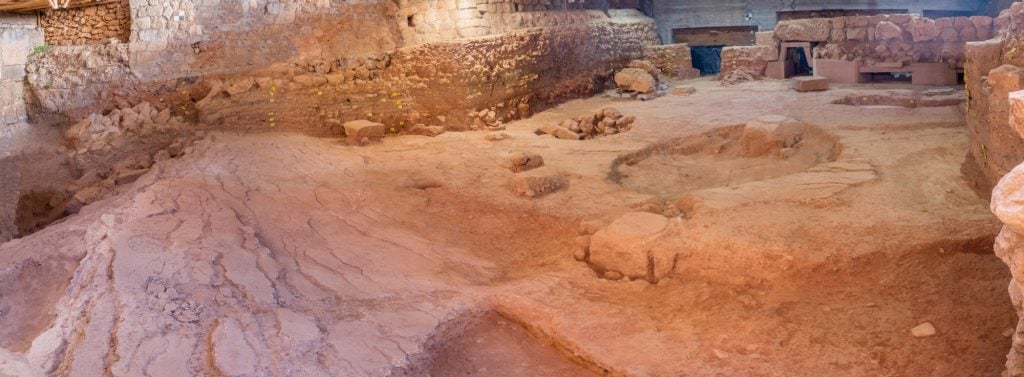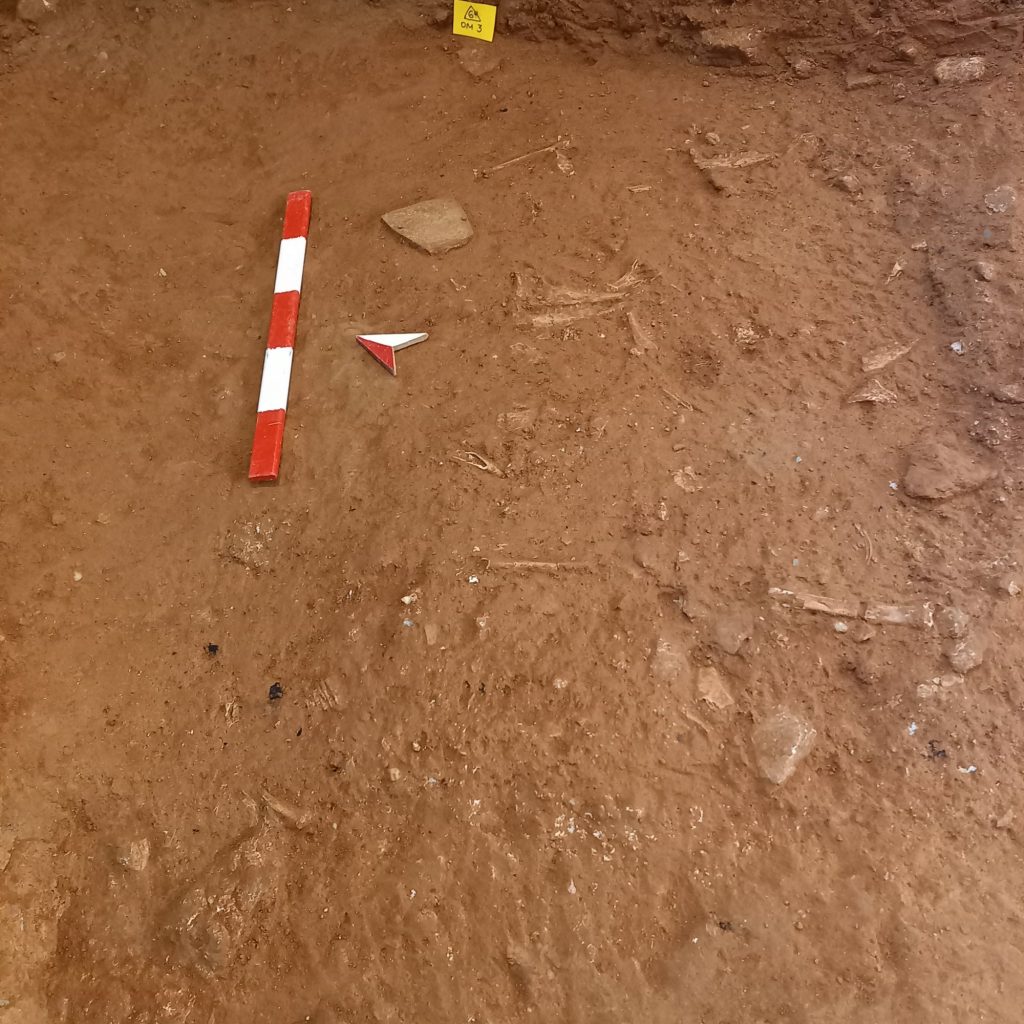
Whether human sacrifices took place in ancient Minoan civilization is a topic of great debate among scholars, with some claiming there is strong archaeological evidence for the practice. Others argue there is no conclusive proof of this.
Evidence pointing to the practice of human sacrifice has been uncovered at a number of sites on the island of Crete in Greece, the primary location of the Minoan civilization, including Anemospilia (20 miles from Knossos) in what is believed to be an ancient temple near Mount Juktas.
Further evidence of such activity has been identified at a sanctuary complex at Fournou Korifi in south central Crete at a building known as North House, Knossos, as well as at the Kastelli Hill archaeological site in Chania in northeastern Crete.
Minoan Human Sacrifice Allegedly Found in Anemospilia
The Anemospilia find—about which an official excavation report has not been published—is described in a National Geographic article from 1981 by two leading archaeologists who were involved in the project.
Yannis Sakellarakis, the director of Crete’s Heraklion Museum at the time and a scholar of Minoan religion and art, and Efi Sapouna-Sakellaraki, a Greek advisor to the American School of Classical Studies in Athens, wrote in the article that they were reasonably certain of certain salient facts.
For instance, “Thirty-seven centuries ago, in a time when savage earthquakes were rocking the island of Crete, a Minoan priest sought to avert final catastrophe with a rare, desperate act: To the deity of his hillside temple he offered up the ultimate sacrifice: a human life,” they wrote.
“But the victim died in vain,” the article continues. “Scarcely had his death rattle ceased than a climactic temblor brought the temple roof and massive stone walls tumbling to earth, killing the priest beside the body of the young man he had just slain.
At the same time, the falling roof killed two others, probably temple functionaries. One was a young woman; the other a person—whether man or woman we do not know—who appeared to have been carrying a sacred vase of a type used for libations of animal blood.”

The body of the young man who had supposedly been sacrificed was found in a strangely contracted position on a raised platform, and a bronze dagger was discovered lying alongside his remains. Osteological studies suggest that the discoloration of the bones on one side of his body is the result of death due to blood loss.
Historian Rodney Castledon seemed to confirm Sakellarakis’ and Sapouna-Sakellaraki’s claim that this find was indeed evidence of a human sacrifice in the protopalatial period of Minoan civilization.
In his book The Knossos Labyrinth: A New View of the ‘Palace of Minos’ at Knossos, he writes about the young boy: “His ankles had evidently been tied and his legs folded up to make him fit on the table. He had been ritually murdered with the long bronze dagger engraved with a boar’s head that laid beside him.”
This find—and the subsequent claims about human sacrifice—drummed up a lot of backlash in the archaeological community, and indeed from the Greek public, as the National Geographic article highlights. “When finally we revealed our discovery and our conclusions, we caused quite a stir both in the archaeological world and among the public,” wrote Castledon.
“Never before, for one thing, had there been strong proof that Crete’s prehistoric Minoans practiced human sacrifice,” the article maintained, “although it had long been suspected. And our fellow Greeks, it soon became apparent, were loath to believe that the Minoan civilization, forerunner of their own, had a dark side.”
Oppositional claims were also made. Nanno Marinatos, Professor Emerita of Classics and Ancient Mediterranean Studies at the University of Illinois Chicago, has argued that the man who was supposedly sacrificed perished in the earthquake that hit at the time of his death. He added that the earthquake destroyed the building, ending the lives of two Minoans who, it is claimed, sacrificed him.
She also pushes back against the function of the building on the site, claiming it was not a Minoan temple and that evidence for the human sacrifice was inconclusive.
Human Sacrifice Evidence at Fournou Korifi
The sanctuary complex at Fournou Korifi forms part of the prepalatial village excavated by British archaeologist and academic Peter Warren in 1967. The hamlet is the first of its kind unearthed on Crete. It is well preserved, with a thorough report being published just a couple of years following the excavation, meaning the site has been analyzed extensively.

Warren claims the fragments of a human skull found in a room with a hearth, cooking-hole, and cooking equipment showed signs of being the remains of a sacrificed victim.
In his book Myrtos: An Early Bronze Age Settlement in Crete, he wrote: “Just beside P574, to the south-west, lay the strangest find from the site, fragments (about a quarter in all) of a human skull. Like the pots the bone was burnt by the destruction fire, but the pieces were identifiable as those of a young adult male.
“No other bones, human or animal, were found,” he explained. “How is this skull to be interpreted? It was certainly not the remains of a burial, nor could it be a last inhabitant who had failed to escape at the moment of destruction; in both cases other bones would have survived. The skull can only have been an object as such, deliberately situated near the tripartite structure with central hearth. Thus the possibilities of ancestor worship or even human sacrifice cannot be ruled out.”
The Find in Knossos
The unearthing of the bones of four children in the Late Minoan ‘North House’ near the central palace at Knossos only served to strengthen Warren’s conviction that the Minoans practiced human sacrifice.
The British School of Athens, led by Warren in 1979, uncovered the mass burials, interpreted as child sacrifice by the British archaeologist and a number of other scholars. Some of the wilder theories also suggested the children had been victims of cannibalism, according to Castledon.

Warren wrote about the supposed sacrifices in his book Knossos: New Excavations and Discoveries. There is “clear evidence that their flesh was carefully cut away,” he revealed, “much in the manner of sacrificed animals. In fact the bones of slaughtered sheep were found with those of the children.”
“Moreover, as far as the bones are concerned the children appear to have been in good health,” he explained. “Startling as it may seem, the available evidence so far points to an argument that the children were slaughtered and their flesh cooked and possibly eaten in a sacrifice ritual made in the service of a nature deity to assure an annual renewal of fertility.”
According to one historian, the senior Cretan archaeologist Nikolaos Platon was so horrified at this suggestion that he insisted the bones had to be those of apes rather than humans.
Some academics argue that the bones were not evidence of sacrifice but of secondary burial. This was a practice wherein bodies are buried twice—once immediately following death and then again after there is no more flesh left on the skeleton. However, this would not explain the cuts and knife marks on the bones.
The Most Recent Evidence of Human Sacrifice in Minoan Civilization
The most recent evidence of human sacrifice in Minoan civilization was discovered during excavation work in Chania at the palace complex of Kydonia. In 2010, a research team led by Dr. Maria Andreadaki Vlazaki uncovered the skull of a young girl from around 1280 BC. The skull was found in pieces alongside those of various animals.

Vlazaki has previously stated she believes the find is indicative of a ritual which included the sacrifice of animals and the girl. Nonetheless, she also clarified that she and her team had not formulated any conclusive answers.
The excavation work that has been taking place in Katre Street, Chania, uncovered a few years ago the large – mostly damaged apart from intact column bases – hypostyle room-hall of the 14th century BC is in progress. The area forms part of the palace complex of Kydonia, from the Creto-Minoan period, which was destroyed by an earthquake midway through the 13th century BC.

The earthquake was followed by the sacrifice of a girl along with 43 goats, a number of sheep, four pigs and two oxen, which is believed to be a unique find of great importance for archaeology, because it presents the first undisputed evidence of human sacrifice in the Minoan period.
It is understood that in the years following the destruction of the hypostyle hall, the area was converted to an outdoor space, where in the Geometric period (8th century BC) large accumulations of broken pithos and sizeable vessels accrued – part of which was discovered in this latest excavation.
See all the latest news from Greece and the world at Greekreporter.com. Contact our newsroom to report an update or send your story, photos and videos. Follow GR on Google News and subscribe here to our daily email!



